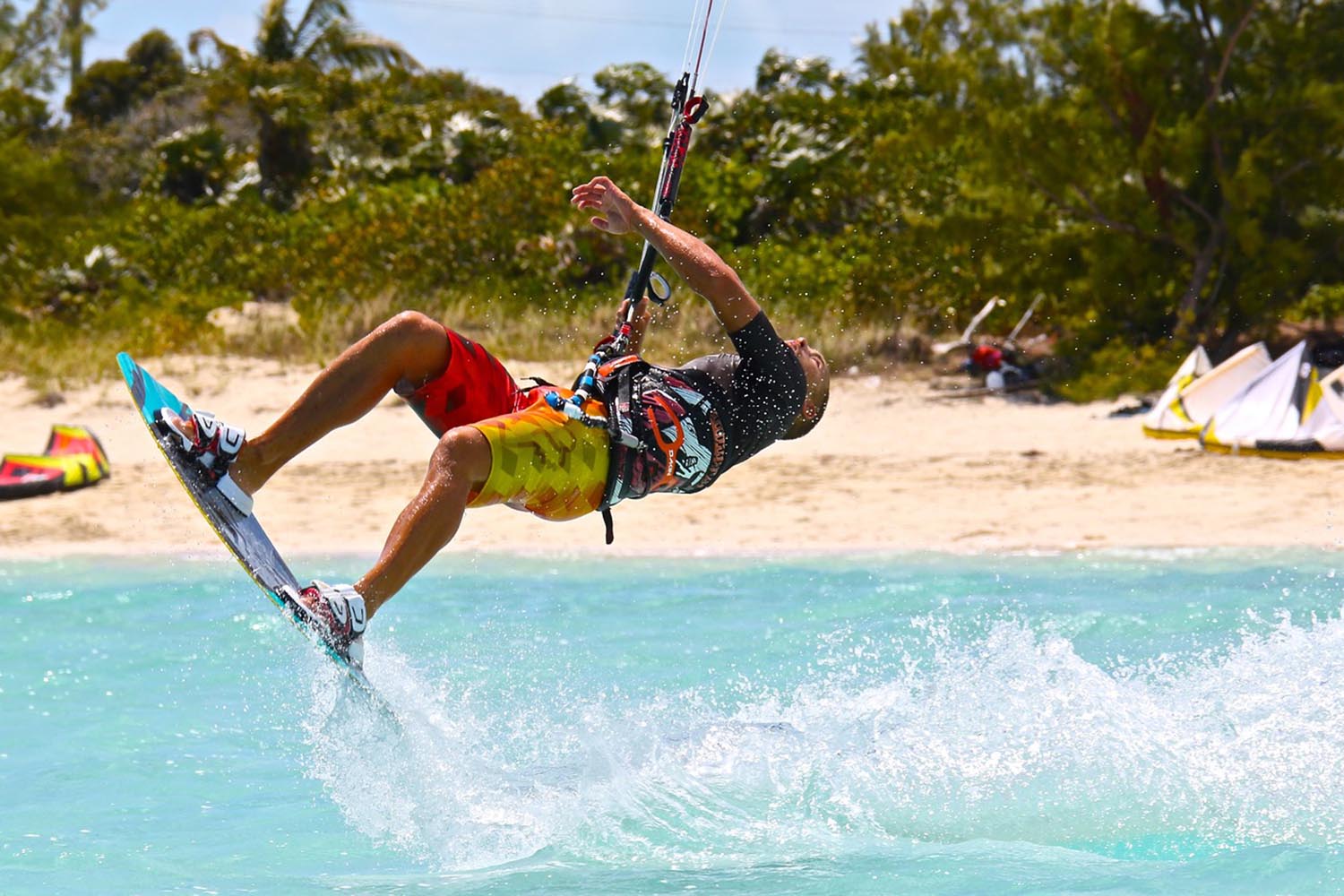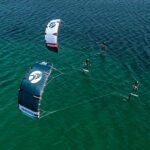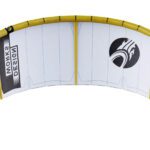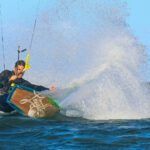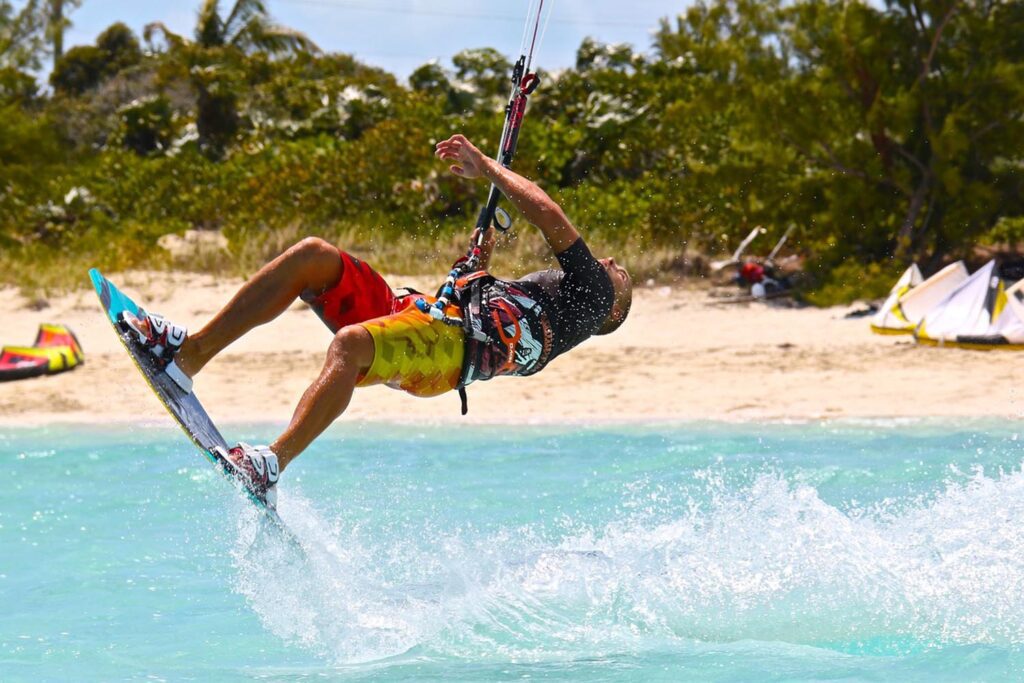
Step-by-Step Kitesurfing Tutorial For Beginners
Introduction:
Welcome to the Step-by-Step Kitesurfing Tutorial! Together, we will embark on an exciting journey to learn and master the exhilarating sport of kitesurfing. Throughout this course, I will provide detailed instructions, ensuring adherence to the IKO rules and guidelines. Let’s begin our first class!
Class 1: Introduction to Kitesurfing
Welcome to your first kitesurfing class! Today, we will cover the basics of kitesurfing and familiarize ourselves with the equipment.
- Definition and History of Kitesurfing: Let’s start by understanding what kitesurfing is. Kitesurfing, also known as kiteboarding, is a thrilling water sport that combines elements of surfing, windsurfing, and kite flying. We’ll explore its origins and how it has evolved.
- Introduction to Equipment: Next, let’s familiarize ourselves with the essential equipment used in kitesurfing. We have the kite, board, harness, lines, and safety gear. I’ll explain the purpose and functions of each item and demonstrate how they are assembled.
- Key Terminology: To communicate effectively throughout our journey, we need to learn the language of kitesurfing. I will introduce you to important terms such as wind window, power zone, upwind, downwind, body dragging, and more.
Good morning, everyone, and welcome to your first kitesurfing class! I’m thrilled to have you all here as we embark on this exciting journey into the world of kitesurfing. Today, we’ll start by laying the foundation and covering the basics of kitesurfing. By the end of this class, you’ll have a solid understanding of kitesurfing and be familiar with the equipment we’ll be using.
Let’s begin with the definition and history of kitesurfing. Kitesurfing, also known as kiteboarding, is a thrilling water sport that combines elements of surfing, windsurfing, and kite flying. It originated in the late 1990s and has since gained immense popularity worldwide. We’ll explore the evolution of kitesurfing, from its early beginnings to the modern sport it is today.
Now, let’s dive into the equipment. In kitesurfing, we have several essential equipment that we’ll use throughout our journey. These include the kite, board, harness, lines, and safety gear. Allow me to explain the purpose and functions of each item.
Firstly, the kite. This is the heart of kitesurfing and the primary source of power. Kites come in various types, such as leading-edge inflatable (LEI), foil, and trainer kites. Each type has its characteristics and is suited for different skill levels and wind conditions.
Moving on to the board, it provides us with the platform to ride and glide on the water. Kiteboards are specially designed to withstand the forces exerted by the kite and come in different shapes and sizes to accommodate various riding styles and water conditions.
The harness is the piece of equipment that connects us to the kite. It distributes the pulling forces from the kite across our bodies, allowing for better control and comfort during our rides.
Next, we have the lines, the vital link between the kite and the control bar. The lines transmit our steering inputs to the kite, enabling us to maneuver and control its movements.
Lastly, we must remember safety gear. This includes a helmet, an impact vest, and a leash. These are essential for our protection and ensure we can enjoy our kitesurfing sessions with added safety measures.
Now that we’re familiar with the equipment let’s briefly go over some key terminology that will be essential for effective communication throughout our kitesurfing journey. I’ll introduce you to terms such as the wind window, which is the three-dimensional space in which the kite operates, and the power zone, which is the area of the wind window where the kite generates the most power. We’ll also cover concepts like upwind and downwind, body dragging, a technique used to maneuver without the board, and more.
Great job, everyone! You’ve completed our first class, and I’m excited to see your enthusiasm for learning kitesurfing. Remember to review the material we covered today, and feel free to ask any questions you may have. In our next class, we’ll dive into the fascinating world of wind and weather conditions, so come prepared and ready to learn. See you next time!
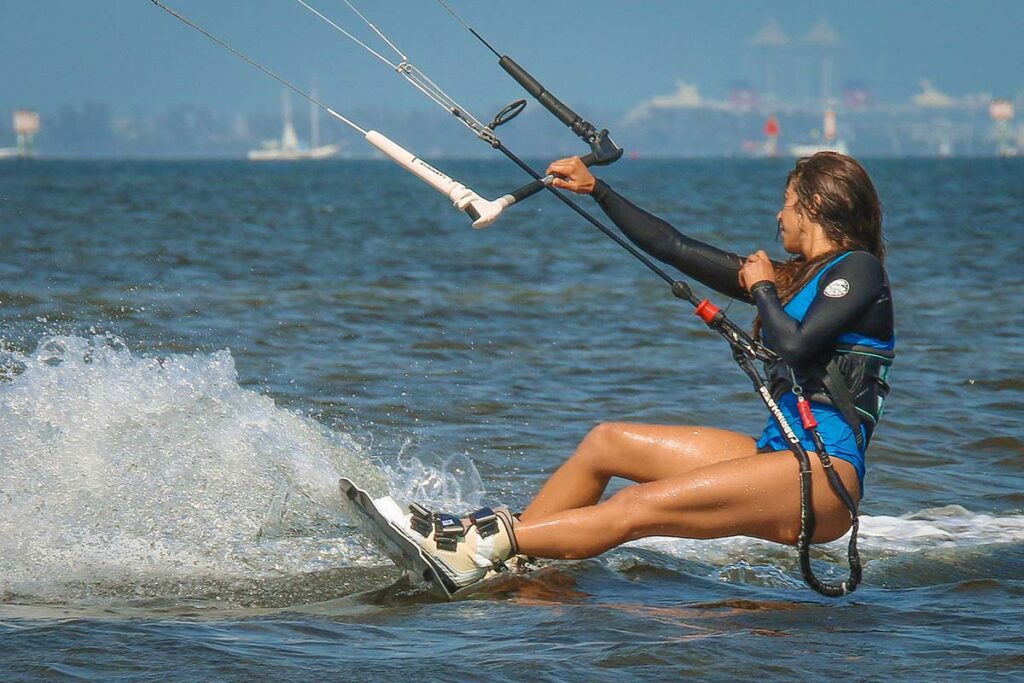
Class 2: Wind and Weather Conditions
Understanding wind and weather conditions is crucial for safe and enjoyable kitesurfing. This class will dive into wind dynamics and how it affects our sport.
- Wind Direction and Speed: Wind direction plays a significant role in kitesurfing. I will explain how to determine wind direction using visual cues and windsocks. Additionally, we’ll discuss wind speed and its impact on choosing the appropriate kite size.
- Safe Wind Conditions: Not all wind conditions are suitable for kitesurfing. We’ll cover the factors contributing to safe wind conditions, including wind strength, gusts, and offshore winds. You’ll learn how to assess the wind quality and choose the right time and place to kitesurf.
Good afternoon, everyone! I hope you’re all ready for another exciting class on kitesurfing. Today, we’ll delve into a crucial aspect of our sport: wind and weather conditions. Understanding these factors is essential for your safety and enjoyment on the water. So let’s jump right in!
First, let’s talk about wind direction and speed. Wind direction refers to the compass direction from which the wind is blowing. It’s important to determine wind direction before heading out to the water. To do this, we can observe visual cues, such as the movement of tree branches, flags, or ripples on the water’s surface. Another helpful tool is a windsock specifically designed to indicate wind direction. By assessing wind direction, we can better understand how the wind will interact with the kite and plan our riding accordingly.
Next, let’s discuss wind speed. Wind speed refers to how fast the wind blows and is typically measured in knots. It’s important to understand the relationship between wind speed and kite size. In general, lighter wind requires a larger kite for sufficient power, while stronger wind necessitates a smaller kite to avoid overpowering and maintaining control. We’ll explore the various wind speed ranges and the suitable kite sizes for each range. This knowledge will help you make informed decisions when choosing your equipment before each session.
Moving on, let’s talk about safe wind conditions. Not all wind conditions are ideal or safe for kitesurfing. We must consider several factors to ensure a positive and secure experience on the water.
One important factor is wind strength. Wind strength refers to the force or power of the wind. We’ll discuss different wind strength categories, from light to strong winds, and the corresponding skills required for each level.
Gusts are another aspect to consider. Gusts are sudden increases in wind speed that can catch us off guard if we’re unprepared. I’ll teach you to safely anticipate and handle gusts, ensuring you maintain control and stability during your rides.
Furthermore, we’ll touch on offshore winds. Offshore winds blow from the land towards the water, and they require special precautions due to their potential to carry riders away from shore. I’ll provide guidelines on recognizing offshore winds and adjusting your riding techniques and strategies accordingly.
To kitesurf safely, assessing the wind quality before heading out is crucial. We’ll discuss factors such as wind consistency, turbulence, and wind conditions at different altitudes. By understanding these factors, you can identify suitable locations and times for kitesurfing, maximizing your safety and enjoyment.
As we wrap up this class, I encourage you to practice wind observation skills and familiarize yourselves with windsocks and other wind indicators. Additionally, take the time to research and understand wind forecasts and local wind patterns in your kitesurfing area.
Well, we did, everyone! You’ve now gained valuable knowledge about wind and weather conditions in kitesurfing. Safety is our top priority, and knowing the wind’s dynamics is key to a successful kitesurfing experience. Our next class focus on safety considerations and the important rules the International Kiteboarding Organization (IKO) established. So, stay tuned, and keep up the great work!
Class 3: Safety Considerations
Safety is paramount in kitesurfing. Today, we will focus on understanding and implementing safety measures to ensure a risk-free experience on the water.
- IKO Safety Rules: The International Kiteboarding Organization (IKO) has established safety rules that must always be followed. I will explain these rules in detail, emphasizing their importance for your safety and the safety of others.
- Hazard Identification and Risk Management: Identifying potential hazards and managing risks is vital in kitesurfing. We will discuss common hazards such as obstacles, swimmers, and other water users. I’ll teach you how to assess the environment, recognize hazards, and take appropriate measures to minimize risks.
Good morning, everyone! Today’s class is all about safety considerations in kitesurfing. As we progress in our kitesurfing journey, we must prioritize safety to ensure a risk-free and enjoyable experience on the water. So let’s dive right in and explore the key safety measures and guidelines.
First and foremost, I emphasize the importance of following the safety rules established by the International Kiteboarding Organization (IKO). The IKO has developed comprehensive safety guidelines to ensure the well-being of all kitesurfers. Let’s go through these rules in detail:
- Equipment Inspection: Before every session, it’s essential to inspect your equipment thoroughly. Check for any damages or wear and tear on your kite, lines, control bar, and harness. Ensure that all connections are secure and any safety systems are functioning correctly.
- Launching and Landing Zones: Always use designated launching and landing areas, if available. These areas provide a clear space for launching and landing your kite, minimizing the risk of accidents or entanglement with other beachgoers.
- Safe Distance: Maintain a safe distance from other kitesurfers, swimmers, surfers, and other water users. This is crucial for everyone’s safety and to avoid potential collisions or entanglement with other equipment.
- Right of Way: Understand and respect the right of way rules. Give way to kitesurfers on starboard tack (riding with the right side forward) and yield to others when necessary. Communication and awareness are key to avoiding accidents on the water.
- Self-Rescue and Assisted Rescue: Learn and practice self-rescue techniques in a challenging situation, such as equipment failure or wind loss. Additionally, be prepared to assist others in need by understanding and executing proper assisted rescue procedures.
Now, let’s move on to hazard identification and risk management. Identifying potential hazards and effectively managing risks is a crucial skill in kitesurfing. Here are some common hazards to be aware of:
- Obstacles: Watch out for obstacles on land and in the water, such as rocks, piers, buoys, or boats. These can pose a significant risk if you come into contact with them during your session. Always assess the area and plan your riding accordingly.
- Swimmers and Water Users: Be mindful of swimmers, surfers, paddleboarders, and other water users in the vicinity. Maintain a safe distance from them and avoid riding in crowded areas to prevent accidents or collisions.
- Changing Conditions: Stay aware of changing weather and water conditions. Keep an eye on shifting winds, tides, and currents, as they can affect your safety and riding experience. Adjust your plans accordingly and be prepared to adapt to the changing environment.
Assessing the environment before each session is crucial to manage these hazards and minimize risks effectively. Take the time to observe the conditions, identify potential risks, and plan your session accordingly. Always prioritize your safety and the safety of others.
Great job, everyone! You now have a solid understanding of the safety rules established by the IKO and the importance of hazard identification and risk management. Always adhere to these rules, be vigilant, and make informed decisions to ensure a safe and enjoyable kitesurfing experience. In our next class, we’ll focus on the essential skill of kite control. So, stay tuned, and keep up the excellent work!
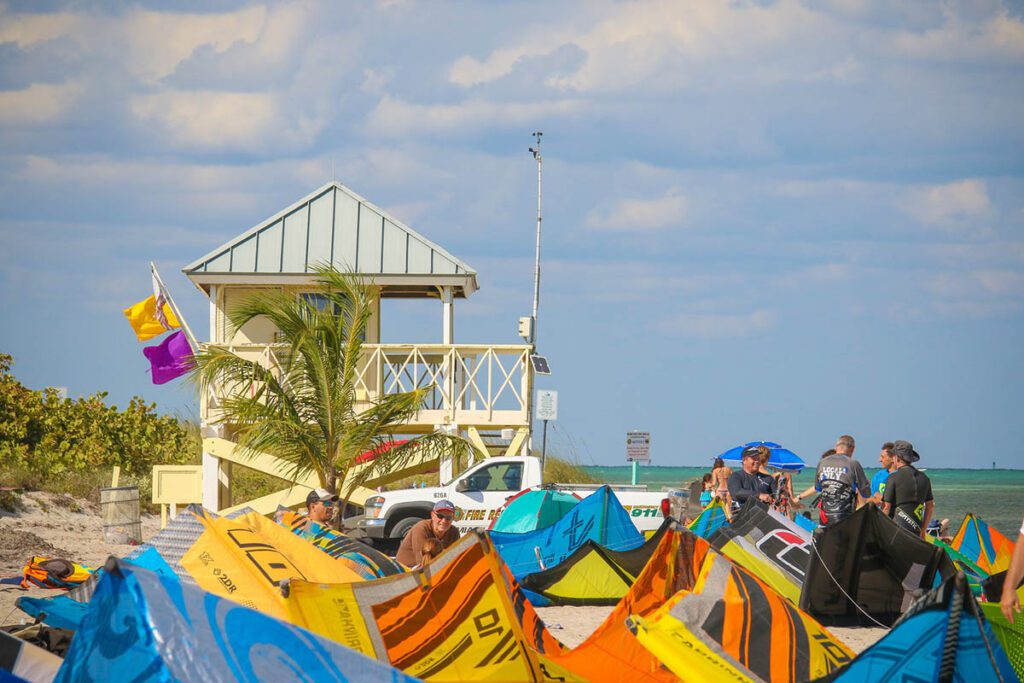
Class 4: Equipment and Setup
Today, we will delve into the equipment used in kitesurfing and learn how to set it up for a successful session properly.
- Kite Types and Sizes: There are various types of kites used in kitesurfing, including leading-edge inflatable (LEI), foil, and trainer kites. I will explain the characteristics of each type and guide you in selecting the appropriate kite size based on your weight and wind conditions.
- Control Bar and Lines: Understanding the control bar and lines is essential for kite control. We will examine the components of the control bar, such as the chicken loop, safety systems, and trimmers. You’ll learn to assemble and inspect the control bar and lines for optimal functionality and safety.
- Kite Setup and Pre-flight Checks: Let’s set up your kite. I’ll demonstrate the proper way to unpack and inflate the kite, attach the lines correctly, and perform pre-flight checks to ensure everything is in working order.
Good day, everyone! In today’s class, we will explore the equipment used in kitesurfing and learn how to set it up properly for a successful session. It’s important to have a solid understanding of your equipment to ensure your safety and enjoyment on the water. So, let’s get started!
First, let’s talk about the different types of kites used in kitesurfing. Leading-edge inflatable (LEI), foil, and trainer kites are the most common types. Each type has its characteristics and is suitable for different skill levels and wind conditions. I will provide an overview of each type and help you determine the most suitable for your needs.
Now that we understand the different kite types let’s focus on selecting the appropriate size. The size of the kite you use depends on your weight and the wind conditions. I will guide you through choosing the right kite size, considering factors such as wind speed and your experience level.
Moving on to the control bar and lines, these are essential components for kite control. We’ll start by examining the different parts of the control bar, such as the chicken loop, safety systems, and trimmers. Understanding how these components work and their purpose will greatly enhance your control over the kite.
Once we have familiarized ourselves with the control bar, it’s time to assemble and inspect it. I’ll demonstrate how to set up the control bar and lines, ensuring everything is securely attached and in proper working order. Safety checks are crucial at this stage, and I’ll guide you through the pre-flight checks to ensure that all components are functioning correctly.
Now, let’s move on to the kite setup. I’ll demonstrate how to unpack the kite carefully, ensuring you handle it carefully to avoid any damage. Following the manufacturer’s guidelines, we’ll inflate the kite using a manual or electric pump.
Attaching the lines correctly is the next step. I’ll show you the proper technique for attaching the lines to the kite, ensuring they are securely connected and free from twists or tangles. Proper line setup is essential for optimal kite control and safety.
Finally, we’ll perform pre-flight checks to ensure everything is set up correctly. This includes checking the lines for twists, inspecting the reins and bridle lines, and verifying that all connections and safety systems are properly functioning.
By the end of this class, you will have a comprehensive understanding of the different types of kites, how to select the appropriate size, and how to properly set up your kite and control bar. Attention to detail during setup is crucial for your safety and equipment performance.
Well, you have done it, everyone! You’re now equipped with the knowledge and skills to set up your equipment correctly. In our next class, we will focus on the essential skill of kite control. So, stay tuned, keep practicing, and I’ll see you next time!
Class 5: Flying the Kite
Mastering kite control is a fundamental skill in kitesurfing. This class will focus on flying the kite and understanding its power and movements.
- Basic Flying Techniques: We’ll start with the basics of kite control. I’ll show you how to use the control bar to steer the kite, control its power, and perform basic maneuvers. You’ll learn how to fly a kite in different areas of the wind window.
- Launching and Landing: Safe launching and landing procedures are essential for a smooth kitesurfing session. I’ll guide you through the techniques for launching and landing your kite, both with and without assistance.
- Wind Window Theory: Understanding the wind window and its zones is crucial for controlled kite movements. I’ll explain the power, neutral, and edge zones and teach you how to utilize them effectively for better kite control.
Hello, kitesurfers! Welcome to Class 5, where we’ll dive into the exciting world of flying a kite. Mastering kite control is a fundamental skill that will pave the way for your kitesurfing journey. Today, we’ll focus on understanding the power and movements of the kite and learn basic flying techniques. Let’s get started!
We’ll begin by exploring the basic flying techniques that will allow you to control the kite effectively. Grab your control bar and get ready to steer the kite! I’ll demonstrate how to use the control bar to steer the kite left and right and control its power by adjusting its angle in the wind. You’ll also learn how to perform basic maneuvers, such as figure eights and loops. Remember, these maneuvers will help you better understand the kite’s response to your inputs.
Now that you know basic kite control, let’s move on to launching and landing procedures. Safe launching and landing techniques are crucial for a smooth kitesurfing session. I’ll guide you through the step-by-step process of launching your kite safely. We’ll cover both launching with assistance from a friend and self-launching techniques. You’ll also learn how to land your kite safely, ensuring it comes down smoothly and under control.
To gain a deeper understanding of kite control, it’s essential to familiarize yourself with the wind window. The wind window is the three-dimensional area where the kite operates in the sky. I’ll explain the different wind window zones: the power, neutral, and edge zones. Understanding these zones will help you anticipate the kite’s movements and control its power more effectively.
We’ll continue building on these basic flying techniques as we progress through this course. We’ll delve into more advanced maneuvers and skills in the upcoming classes. But remember, practice is key! Spend time flying your kite regularly, experimenting with different control inputs, and becoming comfortable with its movements.
Well, you have done it, everyone! You’ve taken important steps toward mastering kite control. In our next class, we’ll explore the thrilling skill of body dragging. Get ready to take your kitesurfing journey to the next level! Stay focused, keep practicing, and prioritize safety above all else. See you in the next class!
Conclusion:
Congratulations, kitesurfers, on completing our comprehensive kitesurfing course! We’ve covered various topics throughout this journey, from kitesurfing basics to more advanced skills and techniques. You have acquired a solid foundation in this exhilarating water sport, and you’re now equipped with the knowledge and skills to embark on your kitesurfing adventures confidently. Remember to prioritize safety, continue practicing, and have fun pushing your limits on the water.
Frequently Asked Questions (FAQ):
Q1: How long does it take to learn kitesurfing?
A1: The learning curve for kitesurfing can vary from person to person. It depends on factors such as your physical fitness, previous experience in related sports, and the amount of time you dedicate to practice. You can expect to become proficient with regular lessons and practice within a few weeks or months.
Q2: Do I need to be a strong swimmer to kitesurf?
A2: While being a strong swimmer is beneficial for any water sport, it is not a prerequisite for kitesurfing. However, feeling comfortable in the water and having basic swimming skills is essential. We always recommend improving your swimming abilities to ensure safety in unexpected situations.
Q3: What are the necessary safety precautions for kitesurfing?
A3: Safety should always be a top priority in kitesurfing. Some essential safety precautions include following the IKO safety rules, wearing a properly fitted harness and safety leash, using appropriate safety gear, regularly inspecting and maintaining your equipment, staying aware of weather and water conditions, and never exceeding your skill level or venturing into dangerous areas.
Q4: Can I kitesurf alone, or should I always have a buddy?
A4: It is generally recommended to kitesurf with a buddy or in the presence of other kitesurfers. Having someone to assist you and watch out for each other enhances safety and allows for quick assistance in case of an emergency. If you choose to kite alone, ensure you are experienced, confident, and knowledgeable about the area and conditions.
Q5: Is kitesurfing an expensive sport?
A5: Kitesurfing can involve some initial investment in equipment, lessons, and safety gear. However, the ongoing costs are relatively low once you have your equipment. Investing in good-quality gear and its proper maintenance to ensure longevity is important. As with any sport, the costs can vary depending on your preferences and your desired level of involvement.
Thank you all for joining this kitesurfing course! I hope you’ve enjoyed the learning journey and gained valuable insights into the sport. Remember to keep practicing, seek guidance from experienced instructors, and continue exploring the vast world of kitesurfing. Safe rides and thrilling adventures await you!
This is just the beginning of our comprehensive kitesurfing course! Stay tuned for the remaining classes, where we will cover body dragging, water skills, board riding, advanced techniques, and more. Remember to practice regularly, stay focused, and always prioritize safety. Great job on completing our first few classes!
Important Notice:
This kitesurfing course provided here is strictly theoretical and intended for informational purposes only. It is essential to emphasize that kitesurfing is an extreme sport that involves potential risks and hazards. The information shared in this course should be used as something other than practical instruction or guidance from a certified kitesurfing instructor.
To ensure your safety and the safety of others, it is crucial to seek proper training and guidance from an International Kiteboarding Organization (IKO) certified instructor. They have the expertise and experience to teach you the necessary skills, provide practical demonstrations, and offer personalized guidance based on your abilities and conditions.
Kitesurfing involves technical knowledge, physical skills, and situational awareness that can only be effectively taught in a practical setting. An experienced instructor will ensure that you receive proper hands-on training, understand safety protocols, and have the opportunity to practice under supervision.
Always remember that kitesurfing should be approached with caution, respect for the sport, and consideration for the natural environment. Prioritize your safety at all times, follow the IKO rules and guidelines, and be mindful of local regulations and conditions specific to the location where you plan to kitesurf.
Please consult with a certified instructor or a reputable kitesurfing school to receive comprehensive and practical training that aligns with the IKO standards. Enjoy your kitesurfing journey, but always prioritize safety and responsible practices.
Disclaimer:
The information provided in this course is accurate to the best of our knowledge and adheres to IKO guidelines. However, we cannot be held responsible for any injuries, accidents, or damages resulting from implementing the theoretical knowledge presented here.
Author
Latest entries
 WatersportsOctober 20, 2024Chasing the Wind: Pushing Limits with the Cabrinha Moto X 12 Meters
WatersportsOctober 20, 2024Chasing the Wind: Pushing Limits with the Cabrinha Moto X 12 Meters WatersportsSeptember 16, 2024Cabrinha Moto X: Enjoy the Ride
WatersportsSeptember 16, 2024Cabrinha Moto X: Enjoy the Ride WatersportsMay 19, 2024Cabrinha 2024 Moto XL Review: The Ultimate Lightwind Kite
WatersportsMay 19, 2024Cabrinha 2024 Moto XL Review: The Ultimate Lightwind Kite WatersportsDecember 16, 2023Kiteboarding Travel
WatersportsDecember 16, 2023Kiteboarding Travel
